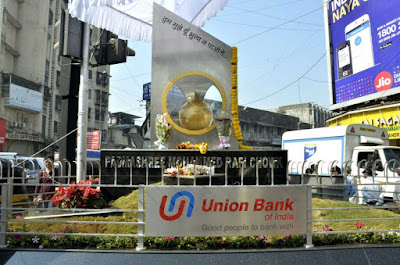There was a news that a road in Andrews Ganj in south Delhi will soon be named after the late actor Sushant Singh Rajput . Naming the streets after Bollywood Celebrities is not new, this is being done from decades. A few years back a Flyover in Mumbai was named after actress Sridevi.
Very recently the Pakistan Govt is thinking of acquiring the ancestral houses of Bollywood heroes Dilip Kumar and Raj Kapoor to be made as museums. The museum will feature biographies, photographs and their affiliation with Peshawar, as well as other records of the two artists and their families.
A street in Pakistan, where the poet and lyricist Gulzar lived with his family, was renamed ‘Gulzar Street’.
Mumbai is the city where Bollywood is situated, many streets or crossings are named after many Bollywood celebrities. There is a crossing at Napean Sea Road named after the great singer Mukesh,
Mohammed Rafi Chowk, SV Road, Bandra, Mumbai Named after the late singer, this chowk is near his bungalow Rafi Mansion, at Bandra.
Another chowk named after music director Kalyanji as Kalyanji Virji Shah chowk, Pedder Road, Mumbai has a granite plaque embellished with musical notes and piano keys to his name.
A chowk named after music director R D Burman in Santacruz (West), Mumbai In 2009, 15 years post the demise of the music composer, this chowk was built near the Burman residence.
Sachin Dev Burman Chowk at the junction of Khar Pali Road (PD Hinduja Marg) and 14th Road in Khar (W). The music maestro’s bungalow was located a few blocks away at Linking Road.
Ismail Merchant Chowk, Byculla, Mumbai With an installation of ink pen, this chowk has been named after Indian born writer, filmmaker Ismail Merchant
A street in Bandra was renamed as Nargis Dutt Road in her memory at Pali Hill, Bandra (West), Mumbai After the demise of the actress. Sunil Dutt mentioned in his will that he did not want anyone to dedicate any building, road or award in his name.
In May 2008, Carter Road was renamed as Sangeet Samrat Naushad Ali Marg, in the memory of Naushad Ali, the veteran music director from the Hindi film industry.
Joy Mukerji Marg, Yari Road, Versova, Mumbai was named after one of the popular Heroes of the sixties. Dilip Kumar and his wife Saira Banu inaugurated the street, rechristened ‘Joy Mukerji Lane’.
As a gesture to honour Manoj Kumar, the Pimpalwadi Road leading to Shirdi was renamed to Manojkumar Goswami road in 2006.
A statue of Bollywood's original superstar Rajesh Khanna was unveiled in Carter Road where he lived, Dimple Kapadia wanted this road to be renamed after him.
A road in Mathura was named after the famous lyricist Shailendra.
The iconic actor-filmmaker has a street named after him in Brampton, Canada. It is called the ‘Raj Kapoor Crescent’.
Similarly, in a street in Markham, Ontario, Canada, was named after the music composer A R Rahman and called the ‘Allah-Rakha Rahman St’.
A garden renamed in the memory of Dev Anand in Pune, called Sadabhaar Dev Anand Udyan. Similarly, a park at Khar in Mumbai which was inaugurated by Rajesh Khanna in the 70s was renamed 'Rajesh Khanna Garden'

















